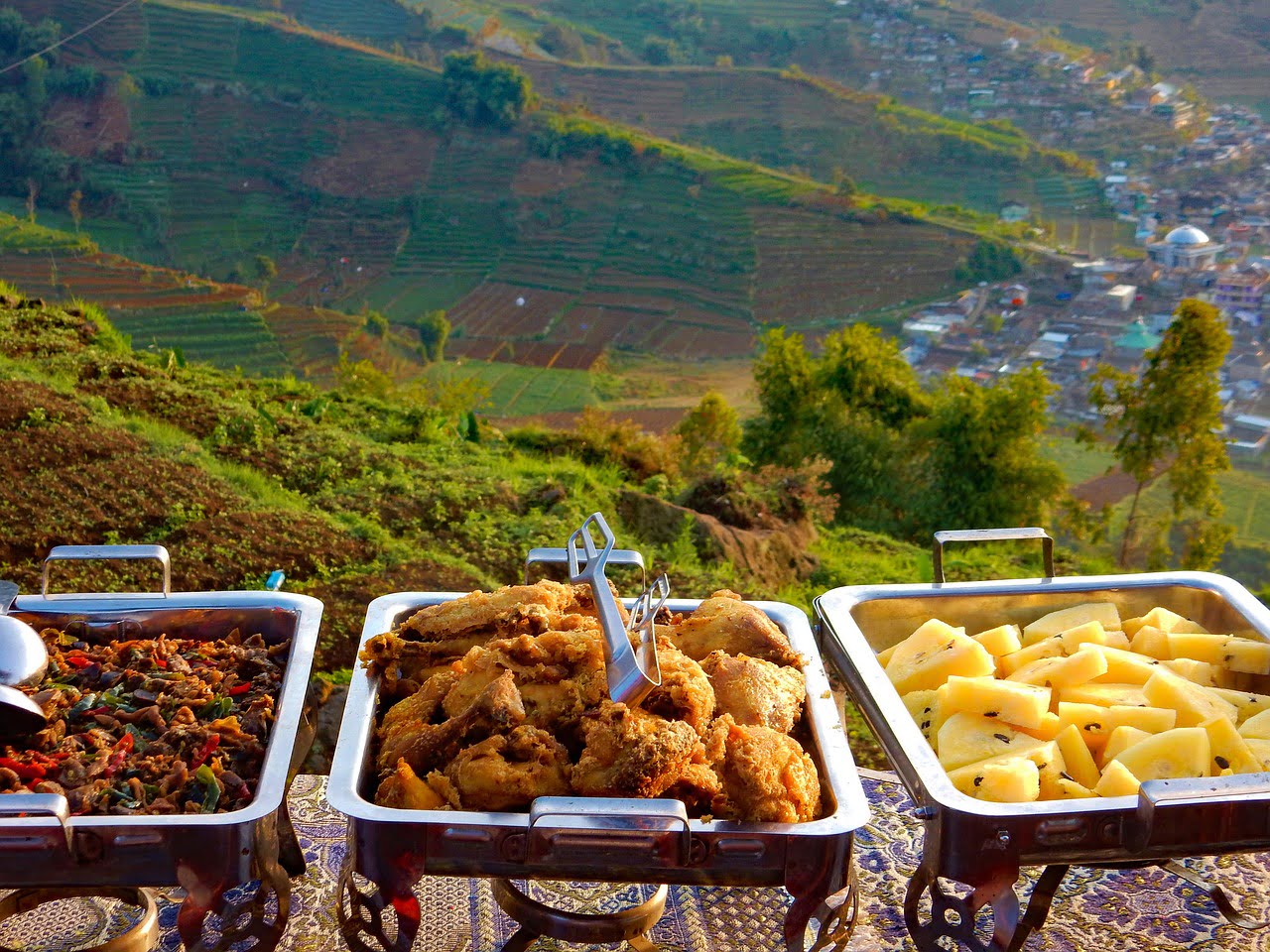Bali: an island paradise where sun-kissed beaches meet vibrant culture. But beyond its scenic beauty, Bali hides a culinary treasure trove waiting to be explored. Food in Bali boasts flavors from across the globe, yet it’s the local Indonesian and Balinese tastes that truly captivate the soul. Imagine the aroma of spices wafting through the air, the sizzle of skewers grilling by the roadside, and the rich taste of coconut-infused delicacies melting in your mouth. For vegetarians, we also have some dishes!
Tasting the local cuisine in Bali isn’t just about savoring dishes; it’s an intimate dance with the island’s culture. From my many dining adventures, I’ve discovered that while restaurants offer a touch of elegance, the most authentic flavors are tucked away in the humble warungs. So, if you’re dreaming of a genuine gastronomic journey, then this will satisfy article will you!
TIP: Bali’s dishes can pack a spicy punch! If you prefer it not spicy, always mention “tidak pedas” to ensure your meal isn’t too fiery. And for those who like their drinks unsweetened, a simple “tawar” will do the trick. Let’s go ahead and check the top 15 must-try dishes in Bali that promise an unforgettable culinary experience.
Babi Guling
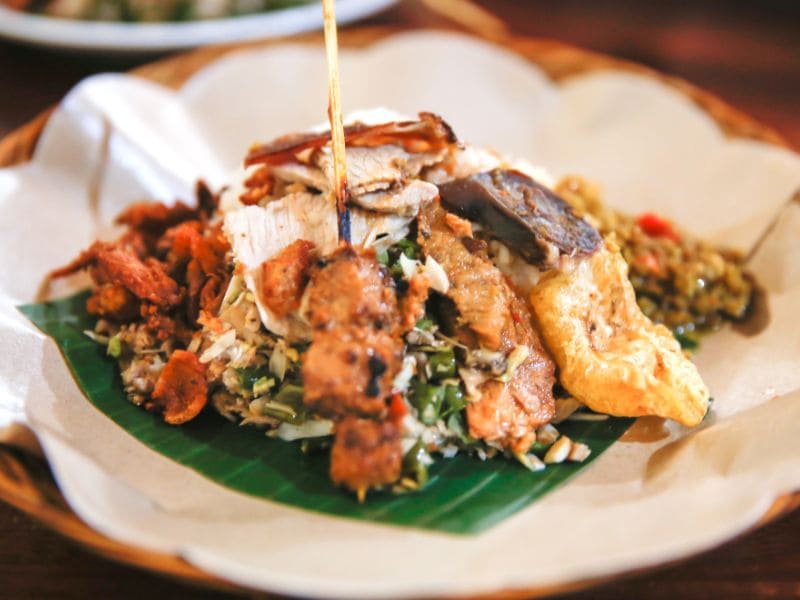
Babi Guling is more than just a dish in Bali, it’s a celebration of flavors. You can’t get this dish in many parts of Indonesia due to religion. But in Bali stands out, embracing this delicious treat with pride. Imagine a whole pig, seasoned with a rich mix of spices like turmeric, lemongrass, and chili. Once it’s all marinated, it’s roasted over an open fire until the skin turns beautifully crispy and golden.
When you sit down to enjoy Babi Guling, expect a plate full of surprises. There’s the tender meat, the crunchy skin, and a flavorful stuffing made from a special blend of spices. It doesn’t stop there. The dish is often paired with steamed rice, fresh local vegetables, and a spicy kick from a side dish called sambal. Some eateries even toss in Lawar and jackfruit for an added taste adventure.
You’ll find Babi Guling in many local eateries, known as warungs. These places often have it as their star dish. But that doesn’t take away from its taste. Every bite is a reminder of Bali’s rich culinary heritage, making it a must-try for anyone visiting the island.
Lawar
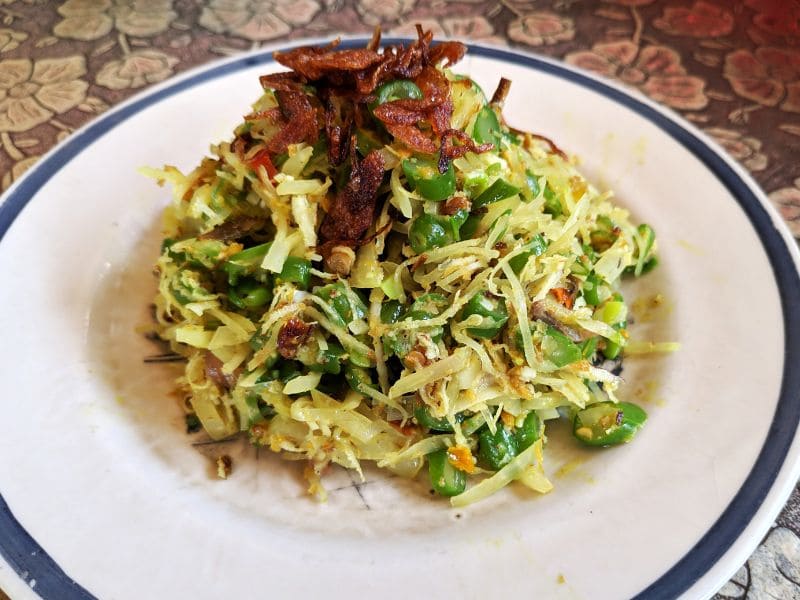
Lawar is a favorite dish from Bali, Indonesia. Think of it as a tasty mix of chopped meat (optionable), veggies, and spices. While pork is often the star in Lawar, chicken can be used too. You’ll also find ingredients like jackfruit and long beans in the mix. And the spices? They’re a flavorful blend of things like turmeric, lemongrass, and chili.
While there are many ways to make Lawar, one special kind is red lawar. It’s rare but has an interesting twist: it uses pig or chicken blood. I got to taste it once after a local ceremony, and it was an interesting experience!
Whether it’s a big event or just a day at a local eatery called a warung, Lawar is a dish you’ll find and love in Bali.
Satay
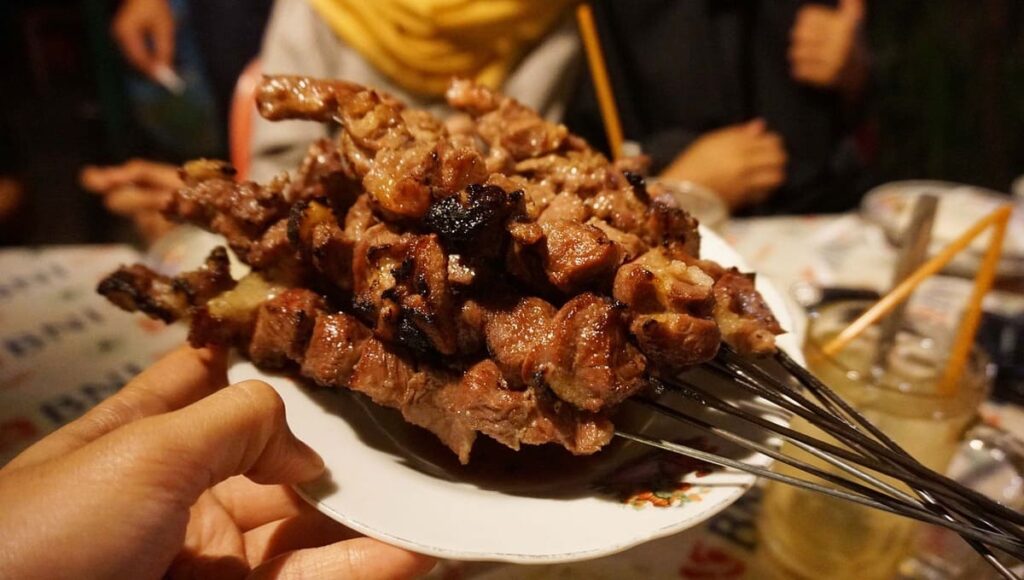
Satay is a tasty treat that comes from Indonesia. It’s skewered meat, grilled to perfection, and served with a yummy sauce. You can find satay made from chicken, beef, lamb, fish, and even goat! The skewers? Usually bamboo. And the grill? Often a simple wood or coconut husk charcoal fire by the road.
What makes satay special is the mix of spices. Think lemongrass, garlic, and chili. After marinating, the meat gets grilled and paired with a creamy peanut sauce. This sauce is the magic touch, making every bite delightful.
Nasi Goreng
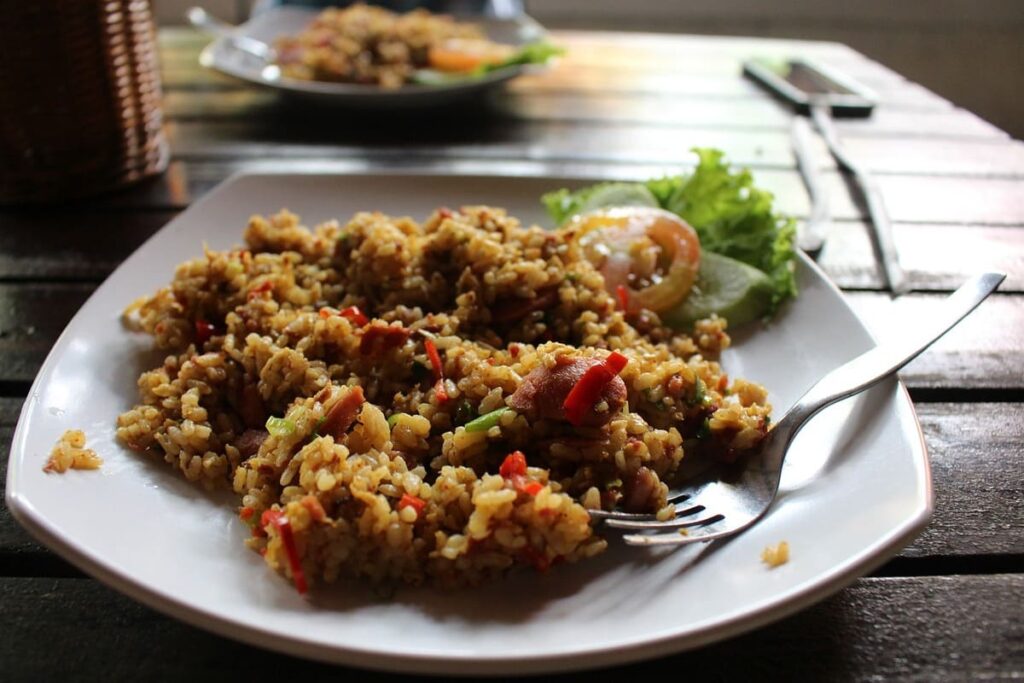
Nasi Goreng means ‘fried rice’ in Indonesian. It’s a favorite dish that comes from Indonesia. The main parts are rice, a little meat, and some onion. The special touch? A sauce called kecap manis. It’s a sweet soy sauce that turns the rice dark brown and makes it taste amazing. Often, there’s a sunny side up egg on top and some fresh cucumber and tomato on the side.
What’s cool about Nasi Goreng is how it’s made. They use cold rice from the day before and fry it up. This gives the rice a yummy caramelized taste. Some places add shrimp paste for an extra kick. If you’ve been to Bali, you’ve probably seen and tasted Nasi Goreng a lot. It’s everywhere and a very known dish in the cuisine of Bali.
Every local eatery, called a warung, has its own version. That’s why it never gets boring. Even though it’s common, it’s one of my top foods in Indonesia. It’s tasty and can be different every time. Many hotels serve it for breakfast, but the best? It’s from a warung.
Mie Goreng
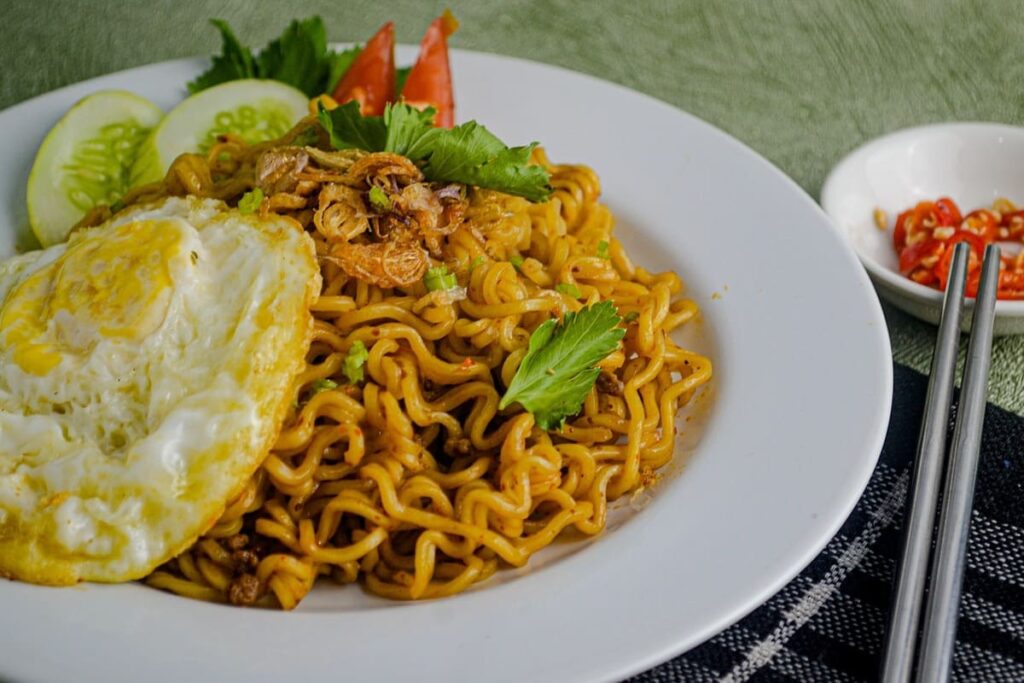
Mie Goreng means ‘fried noodles’ in Indonesian. But guess what? It’s not really fried, but cooked! This tasty dish comes straight from Indonesia. It’s made with noodles, some meat, and onions. The magic touch? A sweet soy sauce called kecap manis (the same one used in Nasi Goreng). This sauce turns the noodles a dark brown and gives them a special caramelized taste. Often, you’ll find a sunny side-up egg on top and some fresh cucumber and tomato on the side.
Making Mie Goreng is fun. Some places add shrimp paste for an extra flavor kick. If you’ve visited Bali, you’ve probably seen and tasted Mie Goreng. It’s everywhere and each place makes it a bit different. Whether you like it vegetarian or with meat, it’s a must-try dish that’s always delicious.
Nasi Campur
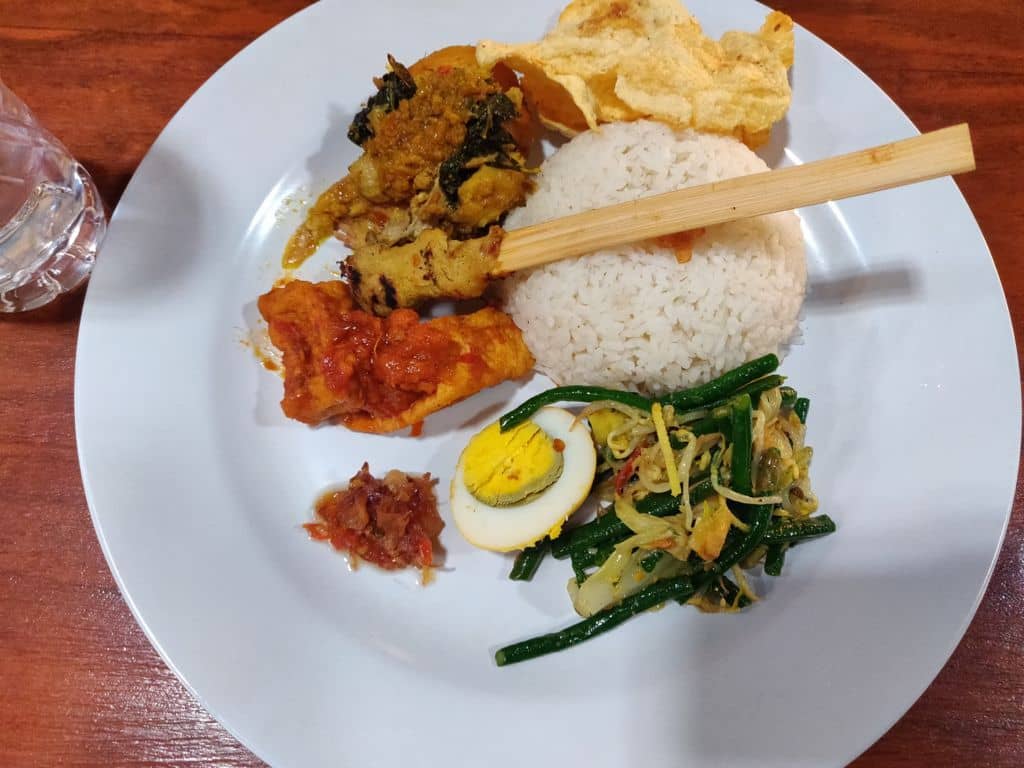
Nasi Campur is a tasty dish from Indonesia. It means ‘mixed rice’. Imagine a scoop of white rice with little bits of other tasty things like meats, veggies, peanuts, and even fried-shrimp krupuk. Every place makes it a bit different. Some might add fish, others might toss in vegetables or meats. It’s a favorite not just in Indonesia, but also in places like Malaysia and Singapore.
There are many ways to make Nasi Campur. In Bali, they have their own special version. It might come with grilled tuna, tofu, spinach, or even beef cubes. And the best part? It’s often wrapped in a banana leaf. The restaurant I was served it on a plate, a bit fancier. If you visit warungs, you’ll see that each one has its own twist on this dish. That’s what makes it exciting. Every plate of Nasi Campur is a new gastronomic adventure.
Bebek or Ayam Betutu
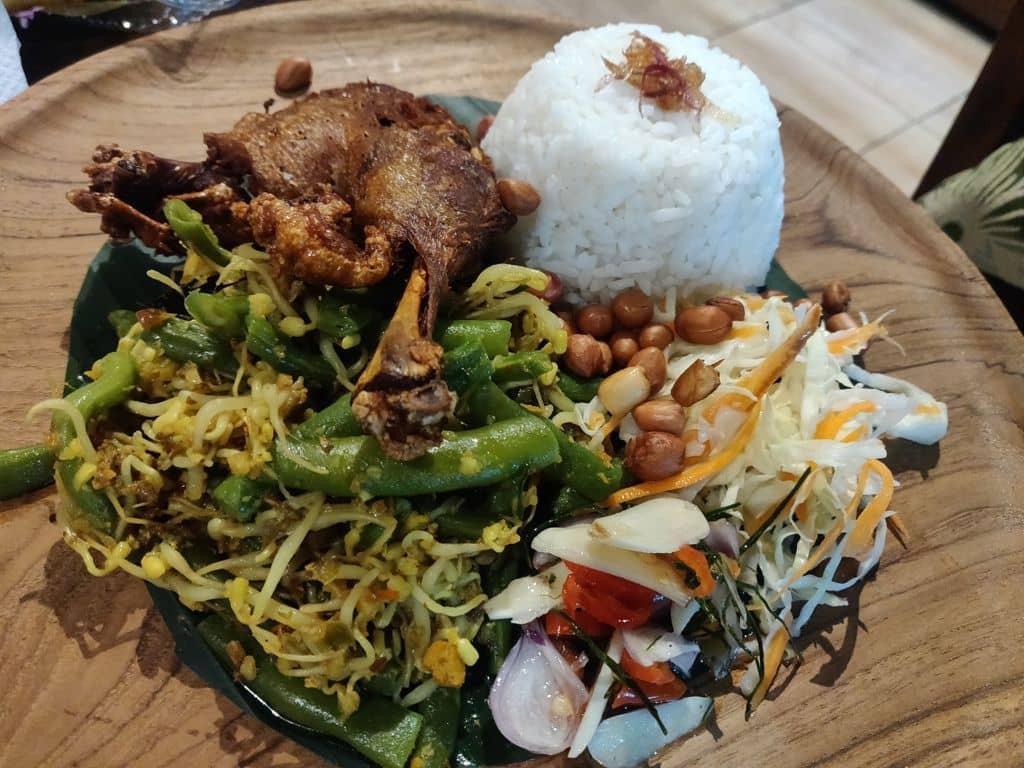
Ayam Betutu is a special dish from Bali, Indonesia. ‘Ayam’ means chicken and ‘Bebek’ is duck. Imagine a whole chicken or duck, seasoned with a Balinese spice called “base genep”, and then roasted over a husk fire. This roasting makes the meat smell and taste amazing. It’s because the heat makes the water and fat in the meat turn into steam. And that steam carries the delicious aroma.
The story of Ayam Betutu started in Gianyar in 1976. A lady named Ni Wayan Tempeh and her husband I Nyoman Suratna began selling it. The name ‘Betutu’ means roasted meat. When you try it, you’ll get juicy, spiced meat that’s a treat for your taste buds. And on the side? Fresh herbs and a slice of cucumber to refresh your palate. It’s a taste of Bali that you won’t forget (source: Ayam betutu Wikipedia)
Lalapan
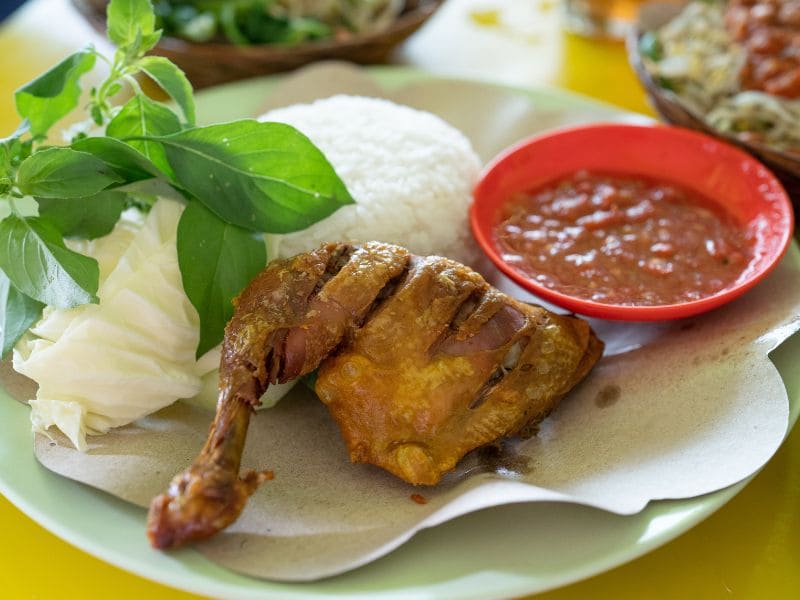
Lalapan is a fresh treat from Indonesia’s Sunda region. Think of it as a salad, but with a twist. It’s mostly raw veggies served with a spicy kick called sambal. You might find lettuce, cucumber, tomato, and even unique greens like cassava leaves in it. Some veggies are boiled, but most are crunchy and raw.
Now, eating raw veggies might sound odd, but trust me, it’s delicious. Especially when you dip them in sambal. It’s not just tasty. With all those veggies, you get lots of fiber which is great for you. If you love fresh, crunchy bites with a hint of spice, Lalapan is a must-try!
Soto Ayam
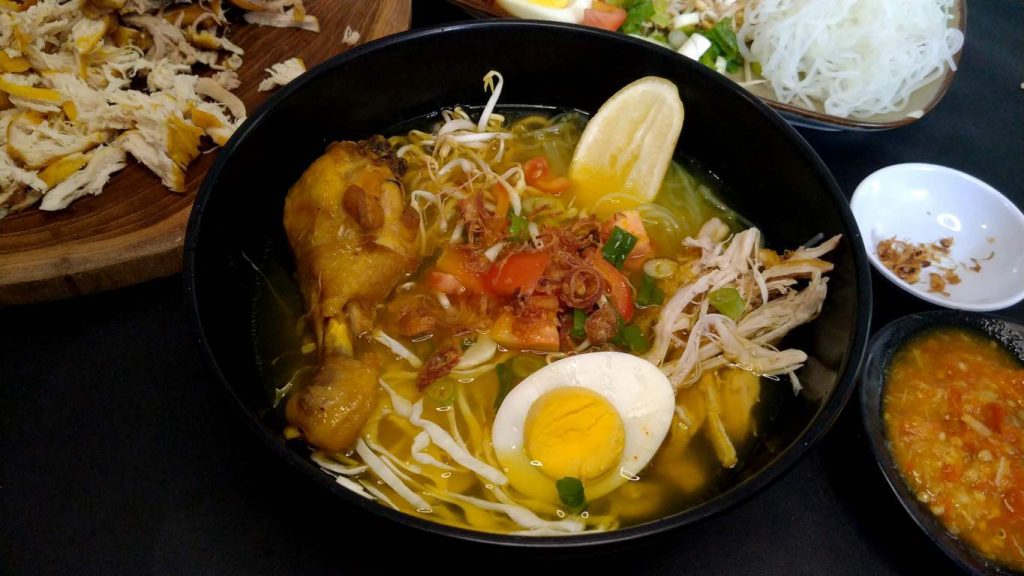
Soto Ayam is Indonesia’s take on chicken soup. Imagine a clear broth, made golden by turmeric and herbs, with thin rice noodles waiting to be discovered. Add a boiled egg, some fried shallots, and fresh herbs, and you’ve got a meal. While chicken is the star, you might also find veggies like jackfruit and long beans in the mix.
Now, you might think, ‘Chicken soup in a warm place like Indonesia?’ But trust me, it’s a hit. It’s one of my favorites. Whether you have it with an egg or without, this soup is pure comfort. And if you pair it with nasi putih, or steamed rice, it’s even better. If you’re in Bali, you’ll see Soto Ayam everywhere. One taste, and you’ll know why.
Seafood
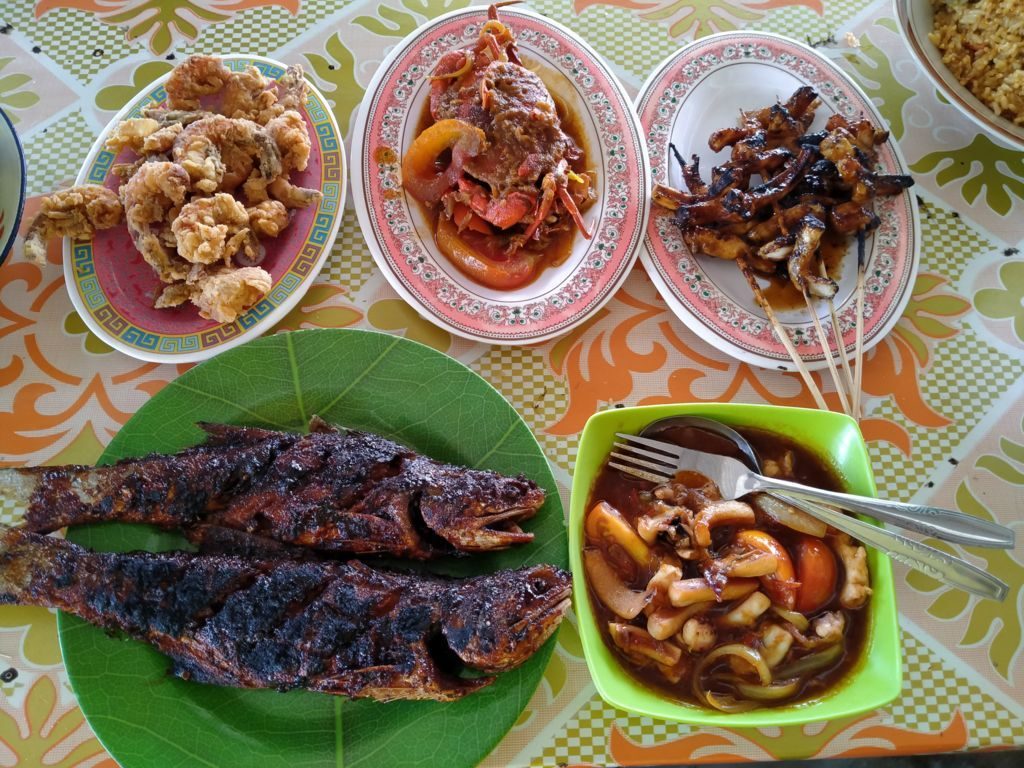
Jimbaran in Bali is a seafood lover’s dream. Right by the beach, you’ll find warungs, or local eateries, serving up the ocean’s best. Think grilled fish, prawns, and even lobsters (sometimes), all fresh from the sea. They spice it up with Balinese flavors and grill it over coconut husks. This gives every bite a special taste.
There are so many places to try. But here’s the thing: Jimbaran is THE place for seafood in Bali. It’s where the island’s seafood market is. Every meal is a fresh catch. So, imagine this: a sunset, the beach, and a plate of the freshest seafood. Sounds perfect, right?
Interested in Jimbaran or other places to stay in Bali? Make sure to discover a lot 🙂
Bakso
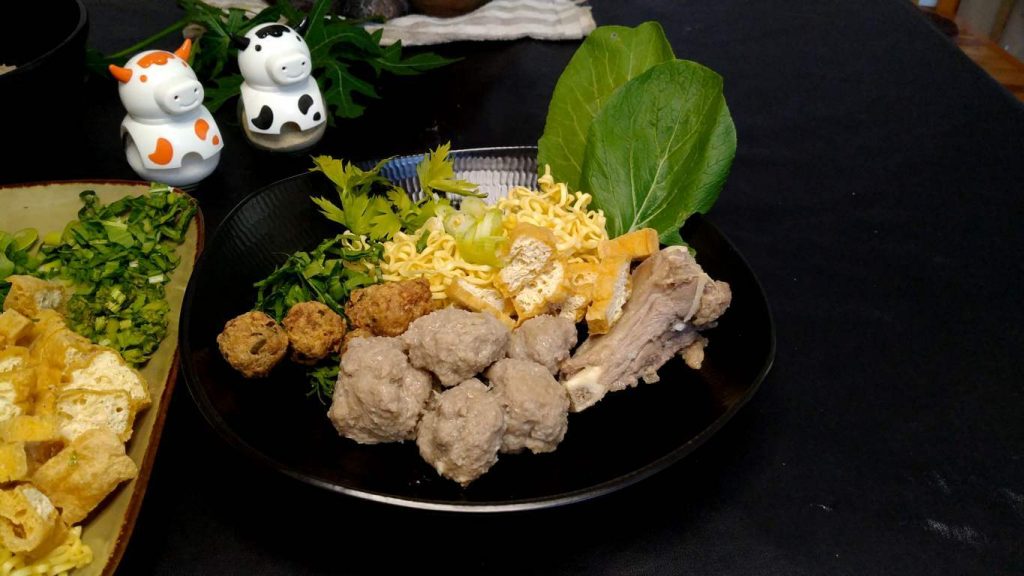
Bakso is Indonesia’s answer to meatball soup. Imagine meatballs made from beef, chicken, or even shrimp, floating in a clear broth. Add some noodles, tofu, and maybe a boiled egg, and you’ve got a tasty dish. Top it off with fried shallots and celery for that extra touch.
Making Bakso is an art. The meat is ground up, mixed with spices and tapioca flour, then shaped into balls and boiled. You’ll find Bakso everywhere in Indonesia, from street carts to fancy restaurants. Some places even sell it frozen for you to cook at home. And if you’re in Canggu, try Bakso Rudi. It’s a local favorite, it will be busy.
Vegetarian
Luckily for Vegetarians, it is not hard in Bali. There are plenty of vegetarian choices. Mie Goreng and nasi goreng can be vegetarian, but there are also other choices. If you are a vegetarian keep in mind that krupuk contains fish.
Tempe & Tahu (Tofu)

Tempeh and Tahu (tofu) are stars in Indonesia’s food scene. Both are made from soy and are favorites for those looking for plant-based treats. Tempeh is like a cake made from fermented soybeans. Tofu, on the other hand, is like a block made from soy milk. It can be soft, firm, or even silky.
They’ve been loved in Indonesia for ages. In fact, tempeh used to be an everyday food, often paired with veggies or rice. Now, it’s a top choice for many, especially those looking for plant-based protein.
And here’s a tip: try them fried. Many local eateries, called warungs, serve crispy tempeh and tofu. If you haven’t tasted them yet, you’re in for a treat!
Gado Gado
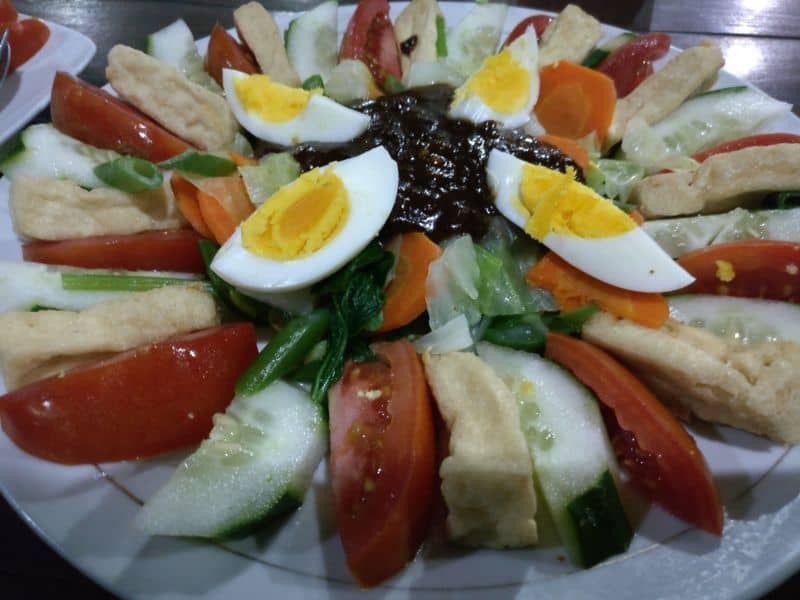
Gado-gado is Indonesia’s vibrant answer to salad. Its name means “mix-mix”, and it’s a delightful blend of veggies, potatoes, eggs, tofu, tempeh, and lontong (rice in a banana leaf). But the real star? The peanut sauce. Made from roasted peanuts and sweetened with kecap manis, a sweet soy sauce, it adds a creamy richness to the fresh ingredients.
Whether you’re at a bustling street stall or a fancy restaurant, Gado-gado is everywhere in Indonesia. If you’re craving veggies with a twist, this dish is a must-try. The combo of fresh greens and that dreamy peanut sauce? It’s a flavor adventure waiting to happen!
Gorengan
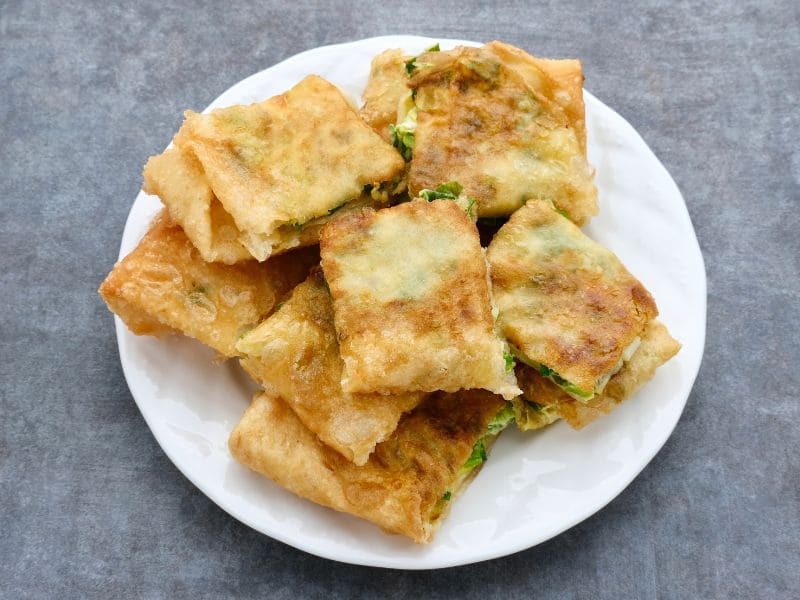
Gorengan is Indonesia’s go-to for deep-fried delights. The name covers a range of snacks, all dipped in batter and fried until crispy. Whether you’re in the mood for something sweet or savory, Gorengan has got you covered. From trendy cafe treats like Churros and Cireng gimbal mozarella to classics like Pisang goreng pasir (fried banana sand), there’s a Gorengan for every craving.
And if you’re wandering the streets of Bali Indonesia, you’ll spot these treats everywhere. Think of tempeh and tahu, coated in a flour mix and fried to perfection. They’re a crispy, oily bite of heaven. Truly, Gorengan is street food at its best!
Pecel
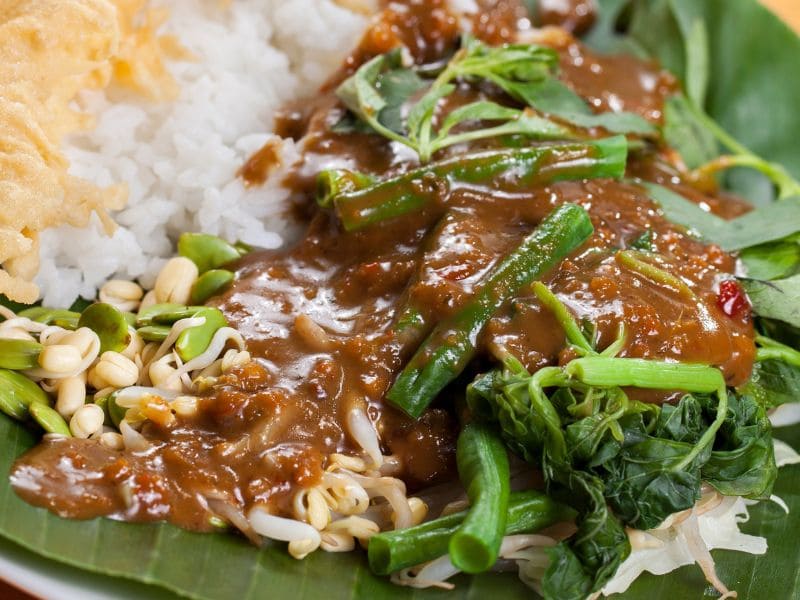
Pecel is like Indonesia’s version of a salad. It’s a Javanese favorite, filled with boiled veggies like spinach and bean sprouts. But the taste maker is the peanut sauce. It’s a tasty blend of ground peanuts and spices. This dish has deep roots, going back to the 9th century in Yogyakarta. You can enjoy Pecel with rice, rice cake, or even rice dumplings. Simple, tasty, and easy on the wallet, it’s no wonder Pecel is loved all over Java!
Thank you for exploring the diverse world of Indonesian and Balinese cuisine with me. From the bustling streets of Jimbaran to the comforting embrace of a bowl of Soto Ayam, each dish offers a unique taste of tradition and culture. If any of these dishes have graced your plate or if I’ve sparked a new culinary curiosity, I’d love to hear from you. Which one was your favorite? Let’s continue our culinary journey through Indonesia together!
Hi I am Dwi. I am a blogger, travel agent and a mom of a lovely daughter and wife to a supportive husband. I customize and plan tours in Bali and islands nearby for a living and have been doing this for more than 14 years. Get in touch via contact [at] taletravels.com
